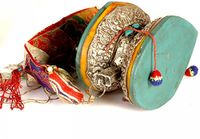Damaru: Difference between revisions
Jump to navigation
Jump to search
No edit summary |
mNo edit summary |
||
| (One intermediate revision by the same user not shown) | |||
| Line 1: | Line 1: | ||
[[Image:Damaru.jpg|thumb|200x200px|Damaru]] | [[Image:Damaru.jpg|thumb|200x200px|Damaru]] | ||
'''Damaru''' (Skt. ''ḍāmaru''; Tib. [[ཌཱ་མ་རུ་]], ང་ཆུང་, or, རྔེའུ་ཆུང་, [[Wyl.]] ''nga chung'' or ''rnge’u chung'') — a small double-sided hand-drum sometimes made from the tops of two skulls and therefore translated as 'skull-drum'. The damaru is held in the right hand, and is frequently paired with the [[bell]], held in the left hand. | |||
'''Damaru''' (Skt. ḍāmaru; Tib. [[ཌཱ་མ་རུ་]], ང་ཆུང་, or, རྔེའུ་ཆུང་ [[Wyl.]] ''nga chung'' or ''rnge’u chung'') — a small double-sided hand-drum sometimes made from the tops of two skulls and therefore translated as 'skull-drum'. The damaru is held in the right hand, and is frequently paired with the [[bell]], held in the left hand. | |||
[[Category: Hand Implements]] | [[Category: Hand Implements]] | ||
[[Category: Shrine and Ritual]] | [[Category: Shrine and Ritual]] | ||
[[Category: Musical Instruments]] | [[Category: Musical Instruments]] | ||
[[Category: Sanskrit Terms]] | |||
Latest revision as of 04:04, 20 August 2017

Damaru (Skt. ḍāmaru; Tib. ཌཱ་མ་རུ་, ང་ཆུང་, or, རྔེའུ་ཆུང་, Wyl. nga chung or rnge’u chung) — a small double-sided hand-drum sometimes made from the tops of two skulls and therefore translated as 'skull-drum'. The damaru is held in the right hand, and is frequently paired with the bell, held in the left hand.